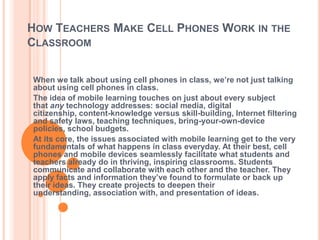
Presentacion yamila y megan
- 1. HOW TEACHERS MAKE CELL PHONES WORK IN THE CLASSROOM When we talk about using cell phones in class, we’re not just talking about using cell phones in class. The idea of mobile learning touches on just about every subject that any technology addresses: social media, digital citizenship, content-knowledge versus skill-building, Internet filtering and safety laws, teaching techniques, bring-your-own-device policies, school budgets. At its core, the issues associated with mobile learning get to the very fundamentals of what happens in class everyday. At their best, cell phones and mobile devices seamlessly facilitate what students and teachers already do in thriving, inspiring classrooms. Students communicate and collaborate with each other and the teacher. They apply facts and information they’ve found to formulate or back up their ideas. They create projects to deepen their understanding, association with, and presentation of ideas.
- 2. WORKING IN CLASS Once the class settles in and things are rolling along, the steady hum gets louder when kids are excited or working together, then quieter again when they’re working out problems on their individual little whiteboards (to be clear, these are not digital). Musallam constantly walks around, sending out directives – “Write the answer on your table!” ““Iwant you guys to come up with an answer now, and text it in,” “What’s the ridonculous choice out of all these answers here?” Students work in groups, and when they have a question, they call him over. He arrives with iPad in hand and records his voice and his writing on the iPad, which he immediately uploads to the class website so other students can benefit from the explanations instantaneously During class, he asks students to take a multiple-choice quiz and send in their answers through a poll on their cell phones. The students’ votes are immediately displayed on the projector that’s hooked up to Musallam’s laptop.
- 4. CÓMO CREAR BELLAS INFOGRAFÍAS SIN SABER DISEÑO GRÁFICO Las infografías son representaciones visuales de información, datos o conocimientos. Se han hecho muy populares en Internet ya que estos gráficos nos permiten captar y comprender rápidamente conceptos difíciles. Nuestro cerebro está especialmente diseñado para el análisis visual combinando imágenes con datos. Las visualizaciones ayudan a transmitir conocimientos de una forma más eficaz que si utilizáramos simplemente texto y números, con lo que pueden ser de gran utilidad en el aula.
- 5. Piktochart es una aplicación web que permite crear bellas PIKTOCHART infografías a partir de unas plantillas y objetos que se añaden con un simple arrastrar y soltar. Permite personalizar colores y fuentes en solo clic siendo muy fácil de usar por los alumnos. También es posible exportar la creación en HTML o como imagen para inscrustar la infografía en una página web o blog. Ofrece tres plantillas en su versión gratuita y ofrece más de 15 en su opción de pago, aunque con precios muy competitivos para la educación. Sn duda es una de las opciones más útiles que se encuentran en Internet.
- 6. EASEL.LY Easel.ly es una herramienta web que permite también crear infografías sofisticadas a partir de plantillas que ofrecen, pudiendo arrastar y soltar dentro de ellas todo tipo de símbolos (líneas, formas, texto, imágenes propias, iconos, etc) para personalizar el resultado final sin perder claridad ni calidad. Las infografías pueden ser exportadas en formatos pdf, jpg, png o web para ser compartidas online.
- 7. INFOGR.AM Infogr.am es una herramienta online relativamente nueva que nos permite subir nuestros propios datos con los que deseamos crear gráficos. Como inconveniente para el aula es que requiere identificarse con la cuenta de Twitter o Facebook pero puede sernos de utilidad como profesores. Podemos editar una URL personalizada para visualizar el gráfico y obtener el código html para añadirlo en el blog o página web.
- 8. Hohli es una herramienta online muy intuitiva y HOHLI sencilla que permite escoger entre una gran variedad de gráficos (diagrama de Venn, diagrama de barras, circulares, radar, etc). Permite introducir nuestros datos, personalizar colores y tamaños y obtener un gráfico de gran calidad para ser insertado en cualquier página web
- 9. MANY EYES Many Eyes es una página web patrocinada por IBM que sirve para explorar visualmente diversos conjuntos de datos en forma de gráficos. Los alumnos pueden subir datos y crear diferentes presentaciones de los mismos o explorar los que ya están elaborados a través de su potente buscador. La filosofía de sus creadores es fomentar la conversación y la colaboración online alrededor de estos gráficos visuales.
- 10. CREAR SUBTÍTULOS EN VÍDEOS DE YOUTUBE O VIMEO En primer lugar debemos registrarnos (es gratis), añadimos el enlace del vídeo que queremos subtitular y empieza el trabajo. Hay un botón que pasa fragmentos de pocos segundos del vídeo y vamos tecleando. Podemos rectificar, volver atrás, cambiar el orden, guardar el trabajo o continuar más adelante. Con un poco de práctica vamos mejorando el ritmo. El segundo paso es sincronizar los textos para que aparezcan en pantalla en el momento justo, usando la tecla tabulación. Al final, después de revisar el proyecto, tomamos el código generado y podemos publicarlo en cualquier blog, página web, moodle, etc. A partir de ese momento cualquiera puede contribuir a mejorar los subtítulos, añadir idiomas, etc.
- 12. BY: YAMILA Y MEGAN
